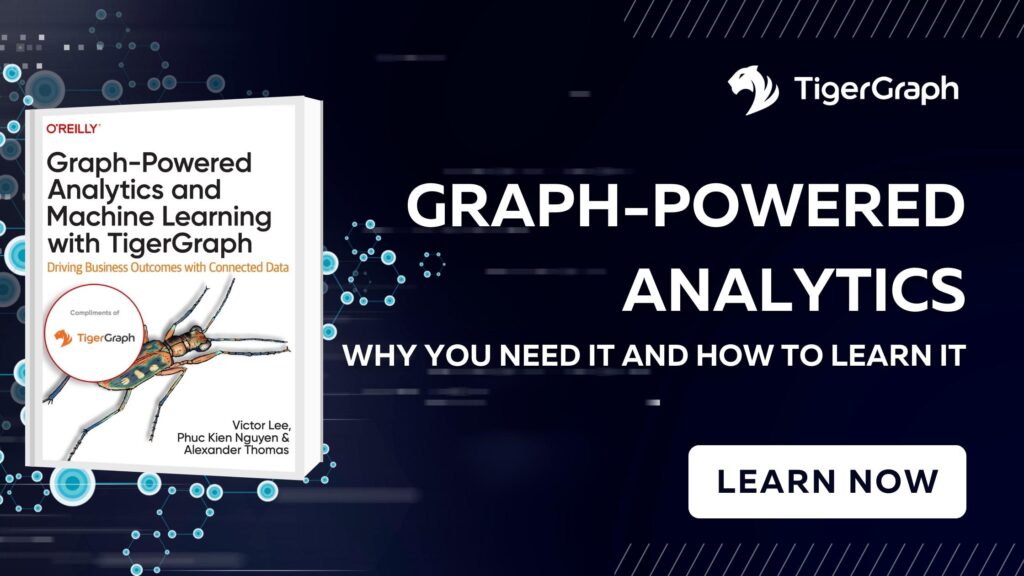Businesses need to stay ahead of the competition, to cut losses, and to find more revenue. By looking at their data as a network and then analyzing the connections – data about customers, products, operations – businesses are achieving those goals. Banks are cutting fraud by millions of dollars. Retailers are making more personalized and responsive product recommendations. Machine learning and AI tools are producing smarter results.
What is the secret here? Graph data and graph analytics. A graph is data in network form, such as a social network. Graphs capture the interdependencies and interrelations, and graph databases let you analyze that data much faster and much more accurately than other types of databases. The ability of graphs to improve analytics is something that businesses cannot ignore. Gartner has estimated that by 2025, graph technologies will be used in 80% of data and analytics innovations [2022 Gartner Market Guide for Graph Database Management Solutions]. Key use cases include financial crime detection, customer 360 with entity resolution, personalized recommendations, and modeling and optimization of operational systems and networks.
Learning and Understanding Graph Analytics
More and more people realize the need to include graphs in their business’ data operations and analytics, but they aren’t sure how to address that need. Most people grasp the concept and structure of graphs, but they’re not sure how to model their data or how to formulate their graph analytics. So we wrote a book: Graph-Powered Analytics and Machine Learning with TigerGraph. We were delighted to partner with O’Reilly, the premier name is computer science and technology educational media, to address this need.
This blog outlines what you’ll learn from this book and its accompanying hands-on examples with TigerGraph. Subsequent blogs will preview each of the blog’s three major sections.
Why This Book?
We designed this book with four objectives in mind:
- To speak to a range of readers, with varying technical backgrounds
- To address the needs of readers with different learning styles
- To fit the needs of readers with busy schedules
- To demonstrate using a platform that excels at graph analytics
First, we at TigerGraph hear from persons in a wide range of roles. Product managers and business professionals need to understand the business value of graph analytics, to find a fit for their needs and use cases. On the more technical side, graph analytics brings together professionals with several roles and backgrounds: Data application developers who know SQL and relational databases want to learn about graph databases and graph query languages. Data scientists and machine learning engineers who are well-versed in data analytics want to know when and how to add graph-based techniques. Engineering managers need to understand the resources and skills needed to have their team perform graph analytics.
Second, apart from your technical background, your learning style may be different from someone else’s. Some learners, like myself, are comfortable understanding material from a conceptual point of view and then applying it to use cases. Others are more attuned to starting from real examples and then generalizing to concepts. Some people learn best by doing a hands-on example.
Third, few of the people who are most interested in a book like this have the time to sit down and read a whole book!
To address these three needs – varying technical backgrounds, varying learning styles, and busy schedules – we came up with the following presentation style and format:
- Present material in two ways: concept chapters and hands-on use case example chapters.
- Introduce and explain concepts using visual aids and analogies to everyday ideas, with supplemental explanations for those with more technical background.
- Present examples in chapters that can be read independently, and out of order in some cases.
The book is structured as a three-part sequence – Connect, Analyze, and Learn – the three stages of sophistication in using graphs and graph analytics. Each part begins with a concept chapter which makes extensive use of analogies and figures so that readers with very little technical background can still follow. Then, each of the three parts has two or three hands-on use case examples. Each of use case chapters begins by presenting a business problem and why a graph-based solution makes sense. We then walk the reader through one of TigerGraph Cloud’s Starter Kits, so that they can see with real data and real queries how the graph analytics works and how it answers those business questions.
A reader who only wants to pick up on the big ideas could read just the concept chapters and skip the example chapters for now. A reader who knows the basics of graph queries and graph analytics but wants to know more about graph embeddings and graph neural networks could skim the first two concept chapters, then really dive into Part 3 – Learn. A reader who is focused on financial crime detection could read the tutorial on using GraphStudio (in Chapter 3), then jump to Chapter 5.
Why TigerGraph?
To address the fourth need – to demonstrate on an excellent graph analytics platform – that was easy. Use TigerGraph and GSQL. TigerGraph is the most scalable and fastest platform for graph analytics. The GSQL query language was designed to be both easy to learn for SQL users and to enable and perform sophisticated, high-performance graph analytics. Using TigerGraph Cloud removes the complications of installing and configuring software. Users only need to sign up for an account, and then they can deploy one free cloud database at a time, as well as pay-as-you-go databases if they wish.
Moreover, we make use of GraphStudio Starter Kits: pre-installed packages each containing a graph schema, graph data, and graph queries aimed at a particular use case, such as fraud detection, entity resolution, cybersecurity, or routing optimization. The queries are already written, so you can simply run them to see the results of the analyses. The book walks through the design of the queries, so that you learn the hows and whys of graph analytics. The combination of TigerGraph Cloud, GraphStudio, GSQL, and Starter Kits makes TigerGraph an excellent platform for showing hands-on use case examples for graph analytics
In our next blog, we’ll tell you more about Part 1 – Connect, as well previewing one of these use case chapters.
Enough preview. You can get a downloadable copy of the book for free from TigerGraph, so why not just see for yourself?
If you’re interested in exploring how TigerGraph can power better insights and better business outcomes, you can sign up for a free instance of TigerGraph Cloud at tgcloud.io or contact us at info@localhost.


